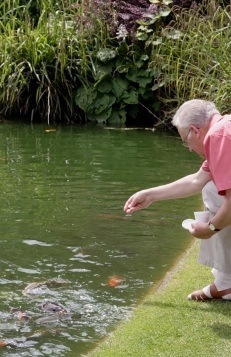We are planning to create a water garden & koi pond in our backyard this summer. What recommendations do you have for planning and lining our pond? — Mary H. Mary, we are sure you'll enjoy the process of setting up your very own water garden, not to mention the wonderful benefits you'll enjoy when it's completed! While there are plenty of sources that discuss design, maintenance and construction of ponds and water features, there are some specific points we'd like to emphasize: One of the most common complaints we hear from new water gardeners is that they feel their pond is too small. Remember that a small pond limits the number of fish and plants you can add, while a larger pond is actually more stable and easier to maintain. Selecting the right liner is just as important as site placement and design. Depending on the type of liner you choose, long-term maintenance can be difficult, and updates to the pond can be nearly impossible! Preformed pond liners offer very little versatility with regard to depth, shape and placement of features. Due to the nature of preformed plastic pond liners, they are likely to crack over time, especially if they are not properly supported underneath. Also, many rigid pond liners are simply too shallow to allow for proper temperature regulation, especially if you intend to keep fish within your pond. Another popular choice for pond liners is EPDM rubber. While it is flexible and safe for fish and plants, it is expensive and prone to tears and leaks. BTL’s liners are ideal for all sizes of fish and garden ponds—even golf course ponds and recreational fishing ponds. Our reinforced polyethylene or polypropylene liners are specifically designed to be fish and plant safe, are highly UV-resistant, puncture and tear resistant, are lightweight, easy to install and less expensive than comparable alternatives. Determine the size and shape of pond that you like by placing a hose or rope on the ground and “designing” your space. To establish the liner size you'll need to order, measure the greatest length and width of the pond, add twice the maximum depth to both measurements, and add about 2 feet on each side for overlap and anchoring. This will give you the final dimensions of your pond liner. If you are adding a new liner in an existing empty pond, drape your tape measure along the bottom of the pond for an accurate measure. For additional help in calculating the amount of liner needed, go to http://btlliners.com/how-to-measure-a-pond/. Mary, please call us at 800-280-0712 if you have any questions! Please consider sharing pictures of the construction process and finished product with us. We love to see the wonderful outdoor spaces our customers have created!
Backyard Water Gardens & Koi Ponds
AquaArmor Pond Liner
The most versatile liner on the market today, AquaArmor maximizes protection from harmful UV rays, tear resistance and punctures that cause leaks. Simply the best liner on the market.Newest Articles:
Subscribe to Updates
Article Topics
Agriculture
Covers
Tarps
Aquaponics
Energy
Liners
Hydroponics
Greenhouse Light Deprivation
Water Gardens
Farm Ponds
Greenhouses
Greenhouse Gardening
Greenhouse Cover
Fish Pond
Pond
Fish
Golf Course Pond
Golf Course Water Feature
Natural Pond
Landfill Cover
Irrigation
Irrigation Pond
Irrigation Canal
Hydraulic Fracturing
Oil Containment
Secondary Containment
Fracking
Oil Liner
Fuel Liner
Frac Pit
Fire Protection Pond
Fire Suppression Pond
Fire Pond
Geomembrane
Canal Liner
Brine Pond
Koi Pond
Algae Pond
Nursery Pond
Retention Pond
Man-Made Lake
Lakes
Geothermal Greenhouse
Commercial Greenhouse
Preformed Pond Liner
Groundwater Storage Lagoon
Mining Pond
Mining Lagoon
Evaporation Pond
Salt Pond
Pond Liner Materials
Catch Basin
Stormwater Management
Barren Pond
Processing Pond
Natural Swimming Pond
Drainage Systems
Ditch Lining
Aquaculture
Sewage Lagoon
Mining Geomembranes
Floating Cover
Wastewater Containment
Geosynthetics
Cistern Lining
Erosion Control
Fertilizer Containment
Winery Water
Silage Cover
Winery Irrigation Pond
Baseball Field Cover
Tailings Pond
Produced Water Liner
Produced Water Winery
Construction Pond
Winter Ponds
Fish Hatchery
Algae Raceways
Coal Ash Containment
Fishing Lakes
Oilfield Pits
Aquatic Habitats
Lake Restoration
Landfill Cell Liners and Cap Covers
Leachate Pond
Rain Cover
Heap Leach Pads
Residential Ponds
Gas Collection
California Drought
California Pond Liner
Overburden Containment
Pond Liner
Fish Stocking Pond
Mine Reclamation
Wastewater Cover
Drought
Irrigation Reservoir
Sludge Management
Cable Parks
Baffle Systems
Alternative Daily Covers
Reservoir Pond
Aeroponics
Food Shortages
Homesteading
Prepping
Toxic Waste
Potable Water Storage
Green Roof
Clearwells
Stormwater Harvesting
Snow Making Ponds
Pond Plants
Hunting Ponds
Oregon Pond Liner
Lavender
Site Runoff Containment
EPDM Liners
Duck Hunting Pond
Deer Hunting Pond
Decorative Ponds
Methane Capture
Large Pond
Sports Field Liner
California Fire Pond
Helicopter Dip Pond
Oregon Fire Pond
Pond Skimming
Geotextile Fabric
Silt Fences
Backyard Greenhouses
DIY Greenhouse
RPE Liners
Desalination
Controlled Environment Agriculture
Living Roofs
Dairy Lagoons
Tank Farm
Wastewater Treatment
Self-Sufficiency
Wicking Bed Liners
Hay Covers
Grow Bed Liner
Light Deprivation Greenhouses
Dam Lining
Frac Pad Liners
Geothermal Energy
Coal Mining
Farming Ground Cloth
Gardening Ground Cloth
Waterfowl Impoundment
Reinforced Polyethylene




